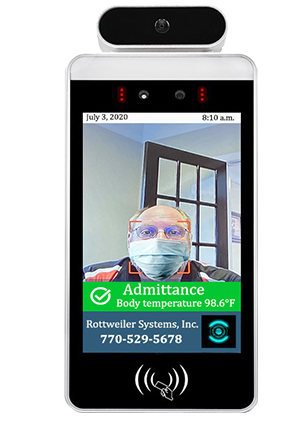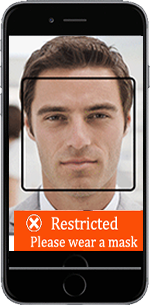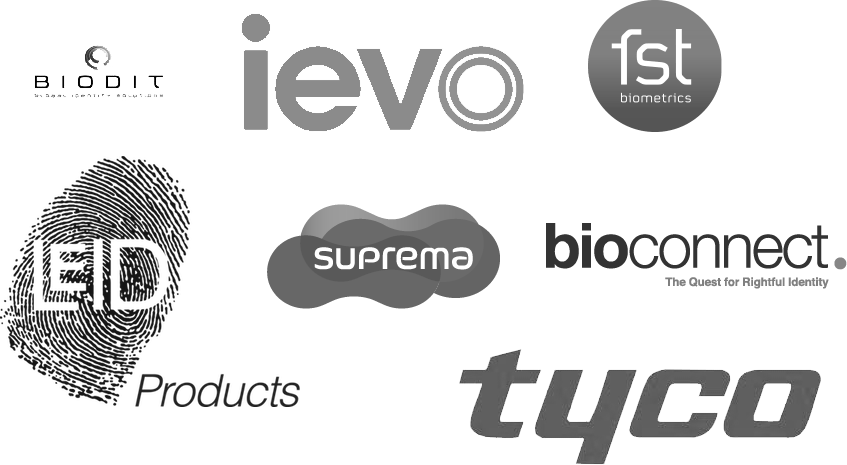
Biometric Temperature Admittance Systems
Identifying Traits
Biometric technology was traditionally associated with fingerprints or iris recognition. Biometric readers have now evolved into full facial recognition, mask wearing detection and fever detection systems. There are many existing and emerging technologies that can recognize other biometric factors as well. These are often used simultaneously to verify an individual's identity programmed into the kiosk and card access system. To highlight a few factors these would include:
- Biometric Facial Recognition (requires setup)
- Fever Detection Alarm Notification
- Fingerprints
- Iris structure
- Hand geometry
- Vein structure
- Entry Temperature Screening
- Signature
- Keystroke recognition
- Gait
- Odor
- Ear shape
How Do Biometric Systems Work?
Once users have their information recorded in a database. This becomes the record that the software compares the record to that powers the system. There are two approaches: verification and identification. Verification confirms that an individual is who he or she claims to be. This is completed by a one-to-one matching model. Identification is a more complex one-to-many query. The database is checked for the individual's biometric data and returns a positive match if he or she has biometric data in the system.
What are the Advantages?

The advantages to a biometric controlled access system are the same as those associated with any controlled access solution: a secure facility, knowledge of who accessed what area when, reduction of "buddy-punching" (when a co-worker clocks a friend in), and control of visitors and unauthorized individuals. Industry estimates place intentional and error-driven time theft in the range of 1.5% to 10% of gross payroll, so the reduction or elimination of that expense will save money long-term. The primary advantage that is unique to biometric system is that a user must be physically present in order to gain access to the building. This prevents a user from sharing his or her PIN code, access card, or password. Additionally, users would not need to remember any codes, since the ID is their physical presence.
Mary Chaney, senior team leader, Incident Response & Data Management, at financial services company GE Capital Americas says,
When measuring both [physiological and dynamic data], the information collected is unique for each individual and rarely changes over time. Once done correctly there is nothing more to do or even remember in some cases. Lost IDs or forgotten passwords may be rendered nonexistent... If you use a dynamic/behavioral biometric measure, like keystroke dynamics, you can gain the advantage of two-factor authentication
Vein structure biometrics is an accurate way to avoid many of the issues that come with current scanner technologies. This solution can work even if the user is wearing medical gloves. It has become a popular alternative to fingerprint scanners in Japan. This is because people in Japan reject the idea of physical contact with the sensors. The contact-less or passive biometric systems offer significant advantages because they have fewer hygiene problems and require less of users.
The Disadvantages
While biometric systems offer a plethora of advantages, there are relatively few disadvantages. The most prominent disadvantage is the cost. Biometric technology is still in the growth phase, so readers and scanners can be more costly than a traditional card access system. A biometric system requires users to enroll and be credentialed, which can be very resource-intensive.
It has been noted that there is sometimes resistance to implementation since users are concerned for privacy. Some scanners, retina or iris scanners in particular, can reveal health issues that individuals would rather keep private. The simple solution is to avoid those types of scanners. There is a risk that biometric data could be pirated and used maliciously, but no more so than PIN codes, key cards, and other solutions.
There have also been issues recorded based on individual traits that make some scanners unable to scan a metric. Individuals sometimes have to physically hold their eye lids open for retina scanners, which impedes usability. While facial topography scanners can avoid this issue, they are less accurate. Some fingerprint scanners cannot read certain skin types. The solution is to create a backup device for users that are unable to be fingerprinted. As technology advances, these issues will reduce significantly.

The Future of Biometric Identification and Fever Detection
Fever detection has become necessary in todays workplace. No longer will it be accepted for employees or vendors to make entry if they have a heightened body temperature. By restricting employees who have a fever other employees that work in close proximity will no longer be permitted to work within proximity of those who do not have a fever. Fingerprint scanners on smart-phones have made biometric security an increasingly popular choice. Several studies have reported that use of biometric devices will increase significantly by 2019. This surge forward will create a public that is very comfortable and accepting of biometric scanners. The result is that the best controlled access systems will incorporate biometric data as a standard feature, rather than a luxury option. The cost of the equipment will fall as technology moves forward.
While fingerprint scanners are an excellent option, "do nothing" technologies will eventually be the standard in biometric systems. Face and iris scanners are excellent examples where the user's identity can be confirmed without the user having to interact directly with any of the technologies.
Currently it is expensive and time-consuming to add users to a biometric system; however, solutions to this problem may include anonymous identification, encrypted transmission of templates, and identity-centric infrastructures with distributed storage models.
Biometric Fever Detection System >>What to Consider
The most important thing to consider is ROI (Return on Investment). A controlled access systems seems like an operating expense that does not directly generate income, but it strengthens the bottom line by securing the building and controlling entry thus avoiding interruptions to the work space. The most obvious example is that of keys and repining of locks. When a user is terminated their information is simply deleted or set to inactive. Another way to save is on payroll expenses. Since the system doubles as a time-card verification database, you can eliminate whatever systems you have been using to track hourly labor. Since users cannot clock in or out without being present, it reduces the amount of fraudulent clock-ins, such as "buddy-punching". Also, since the system is more accurate, it has shown reductions in overtime expenses. It has been estimated that time-and-attendance systems can pay for themselves within a year.
Other factors to consider are:
- Fever Detection Scanner: Fever Detection helps remove flu carriers from working in the workplace.
- Elimination of Time Theft: A record of entry also is a record of the time when employees actually entered the office.
- Biometric Scanner: Are you interested in fingerprint, retina, facial topography, or another type of metric?
- One metric or many? Do you want to use a multi-modal system that reads two or more different metrics or only a single solution?
- Areas of Access: With any controlled access system areas of controlled access are a critical component to consider.
- System usability: Can everyone use the system? Do you need to make exceptions for some individuals?
- Regulation: If you work in an industry that is regulated you should understand those regulations before installing a biometric system.
Top Biometric Companies to Keep an Eye On


Articles on Biometric Systems
Biometric Fever Detection System >>Biometric security is on the rise >>
Biometric Companies >>
M2SYS on Biometric Trends in 2015 >>